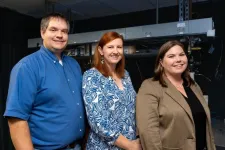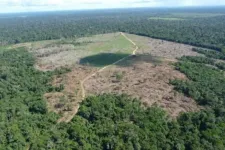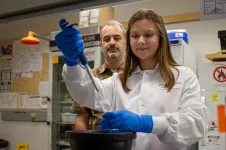(Press-News.org) Funded by a five-year, $20 million grant from the U.S. National Science Foundation (NSF) and the Simons Foundation, the National Center for Supercomputing Applications is partnering with other academic institutions and federal laboratories in the Midwest to develop new artificial intelligence (AI) tools to advance astrophysics research and exploration of the universe.
Led by Northwestern University, the collaboration will establish the NSF-Simons AI Institute for the Sky or SkAI (pronounced “sky”), one of two AI research centers that will help astronomers better understand the cosmos.
Located close to NCSA’s home in Illinois, SkAI will bring together researchers to create and deploy innovative AI mechanisms that will analyze large datasets from astronomical surveys and transform physics-based simulations in pursuit of furthering deep space exploration. SkAI will unite 83 team members from 25 partner organizations, including NCSA, Northwestern University, the University of Illinois Urbana-Champaign, the University of Chicago, Argonne National Laboratory, Fermi National Accelerator Laboratory, the University of Illinois Chicago, the Adler Planetarium and University of Wisconsin-Madison.
“Our mission at the Center for AstroPhysical Surveys (CAPS) in NCSA has been to bring together innovative software and cutting-edge hardware to tackle the most pressing questions in the universe” said SkAI co-principal investigator and CAPS Deputy Director Gautham Narayan. “We’re very excited to have our students, postdocs, faculty and staff deepen our involvement with our colleagues at Northwestern and U of Chicago, provide the entire SkAI community access to NSF’s Delta and DeltaAI supercomputers here at NCSA and build tools and services that lead to AI methods becoming more interpretable and reliable. Our goal is to democratize AI and make it more trustworthy – not just for astrophysics and cosmology, or our campus, but for everyone. This is a big leap forward, and Illinois will lead the way.”
“I am thrilled to receive this opportunity to work with our amazing cross-disciplinary, multi-institutional team, so we can accelerate the data-driven revolution that wide and deep sky surveys will bring to the field of astronomy,” said Northwestern’s Vicky Kalogera, SkAI director and principal investigator of the grant. “We will transform our astrophysical understanding across an enormous range of scales – from stars and the transients they produce to the evolving galaxies they live in, the black holes they form, and to the dark sector of the universe and its cosmological origins.”
Astronomical surveys like the Vera C. Rubin Observatory and CMB-Stage 4 experiment promise transformational advances in astrophysics and cosmology. Realizing these breakthroughs will require overcoming enormous challenges in data analysis, modeling and experiment design. Researchers will need assistance provided by these SkAI resources to sufficiently interpret increasingly large and complex datasets.
The massive amount of data that will be gathered in the coming years by the NSF-DOE Vera C. Rubin Observatory and other large-scale astronomical projects is simply too vast and rich to be fully explored with existing methods. With reliable and trustworthy AI in their toolbox, everyone from students to senior researchers will have exciting new ways to gain valuable insights leading to amazing discoveries that might otherwise remain hidden in the data.
Sethuraman Panchanathan, NSF Director
SkAI will also be a bastion for open science and emphasize diversity of disciplines and researchers in its work. Building on existing partnerships with urban and rural community colleges, minority serving institutions, youth organizations, the Adler Planetarium, artists and art organizations, and industry professionals, the new institute will develop Astro-AI educational and workforce-development resources for high school students through postdocs. SkAI will engage the public around Astro-AI concepts and enhance local, regional and national research capacity and knowledge transfer to the community, higher-learning institutions and in industry. Activities will be designed to lower barriers to access and grow a more diverse STEM workforce.
“Our research will be guided by AI ethics principles and all SkAI members will be trained in key AI ethics practices,” Narayan said. “Our commitment to open collaboration ensures that SkAI research products are adopted widely. We will develop new, trustworthy AI tools in an open-source ecosystem and train a diverse generation of scientists and engineers to ethically apply and extend AI within academia and beyond.
“University of Illinois leadership and their vision in creating the Center for AstroPhysical Surveys has enabled us to get a head start in these areas, and was crucial to the success of SkAI, and their continuing support gives us the freedom and ability to innovate. By pushing the frontier of computing, we’re reaching ever more distant horizons in the universe.”
For more details on SkAI, check out the announcements from NSF and Northwestern University.
ABOUT ASPO/CAPS
NCSA’s Center for AstroPhysical Surveys (CAPS) brings cohesion and advancement to astrophysical survey science efforts across the University of Illinois Urbana-Champaign. CAPS offers annual postdoctoral and graduate fellowship programs, publishes vast amounts of astronomical data from a broad portfolio of astrophysical surveys and collaborates across disciplines to enable trailblazing research.
END
SkAI launched to further explore universe
NCSA and partner institutions received a $20 million grant to create new artificial intelligence tools for space exploration
2024-09-20
ELSE PRESS RELEASES FROM THIS DATE:
SLU researchers identify sex-based differences in immune responses against tumors
2024-09-20
ST. LOUIS — Researchers at Saint Louis University School of Medicine investigated differences in T-cell responses between male and female patients with lung cancer that may help direct future treatments. T-cell responses are part of the adaptive immune system, part of the body’s “smart system” that monitors for threats and fights them with customized defenses.
"Therapies that use the patient's immune system to fight their disease have a lot of potential to ...
Evolved in the lab, found in nature: uncovering hidden pH sensing abilities
2024-09-20
By Andy Flick, Evolutionary Studies scientific coordinator
In a groundbreaking study led by Sarah Worthan, Ph.D., a postdoctoral researcher in the Behringer Lab at Vanderbilt University, scientists have successfully evolved microbial cultures that possess the ability to sense pH changes, enabling rapid responses to environmental fluctuations. Along with highlighting the power of lab-driven evolution, this discovery also led to finding similar mutations in nature in emerging pathogens and coral symbionts—organisms that navigate challenging pH shifts in their environments and are ...
Unlocking the potential of patient-derived organoids for personalized sarcoma treatment
2024-09-20
Investigators at the UCLA Health Jonsson Comprehensive Cancer Center have developed the largest collection of sarcoma patient-derived organoids to date that can help improve the understanding of the disease and better identify therapies that are most likely to work for each individual patient.
The approach, detailed in the journal Cell Stem Cell, uses patients’ own tumor cells that replicate the unique characteristics of a patient's tumor allowing scientists to quickly screen a large number of drugs in order to identify personalized treatments that can target this rare and diverse group of cancers.
“Sarcoma is a rare and complex disease, which makes conducting clinical trials ...
New drug molecule could lead to new treatments for Parkinson’s disease in younger patients
2024-09-20
A novel drug molecule could potentially lead to new treatments to prevent Parkinson’s disease in younger patients, according to new research.
“We are excited about this drug compound because we might have the possibility to develop the first cure for Parkinson’s disease, at least for a subset of patients,” said lead author Kalle Gehring, a Professor in the Department of Biochemistry at McGill University and Canada Research Chair in Structural Studies of Neurodegenerative Diseases.
While Parkinson’s symptoms — slowed movements, tremors and balance problems — often appear in ...
Deforestation in the Amazon is driven more by domestic demand than by the export market
2024-09-20
Brazilian Legal Amazonia (BLA) – which comprises the entirety of the Amazon Basin located in Brazil and vast adjacent swathes of the Cerrado, spanning nine states – is more than 5 million square kilometers (km2) in area and corresponds to almost 60% of the country’s land mass. Almost a quarter of this area (23%) has been deforested, and over 1 million km2 are degraded, so that the region risks reaching an ecological tipping point at which ecosystems collapse and billions of tons of carbon are released into the atmosphere. Some parts of ...
Demand-side actions could help construction sector deliver on net-zero targets
2024-09-20
Using state-of-the-art energy efficiency technologies to renovate existing properties and construct new ones could enable Europe’s construction sector to almost eliminate its carbon emissions by 2060, a new study suggests.
Published in the journal Renewable and Sustainable Energy Reviews, the research is the first to fully assess the potential for energy demand reduction across the construction sectors of the United Kingdom and all European Union member states.
It highlights that 75% of Europe’s building stock is currently classed as energy inefficient, with total floor space also ...
Research team discovers molecular mechanism for a bacterial infection
2024-09-20
Virginia Tech researchers have learned how bacteria manipulate molecules to infect the host organism.
Daniel Capelluto and his research team have discovered the mechanism by which the bacterial pathogen Shigella flexneri, the causative agent of dysentery, manipulates molecular activity to assure its survival against its host’s natural defenses. Their findings were recently published in Structure, a Cell Press journal that supports open access.
“This infection strategy may be employed by other bacteria, making this research a potential foundation for understanding the molecular mechanisms underlying various bacterial infections,” said Capelluto, associate professor ...
What role does a tailwind play in cycling’s ‘Everesting’?
2024-09-20
WASHINGTON, Sept. 20, 2024 – Within the cycling realm, “to Everest” involves riding up and down the same mountain until your ascents total the elevation of Mt. Everest — 8,848 meters.
After a new cycling “Everesting” record was set a few years ago, a debate ensued on social media about the strong tailwind the cyclist had on climbs — 5.5 meters per second (20 kilometers per hour or 12 miles per hour) — when he set the record. To what extent did the tailwind help him? Should limits be set on the allowed ...
Projections of extreme temperature–related deaths in the US
2024-09-20
About The Study: This cross-sectional study found that extreme temperature–related deaths in the contiguous U.S. were projected to increase substantially by mid–21st century, with certain populations, such as non-Hispanic Black and Hispanic adults, projected to disproportionately experience this increase. The results point to the need to mitigate the adverse outcome of extreme temperatures for population health.
Corresponding Author: To contact the corresponding author, Sameed Ahmed M. Khatana, MD, MPH, ...
Wearable device–based intervention for promoting patient physical activity after lung cancer surgery
2024-09-20
About The Study: In this nonrandomized clinical trial, integration of perioperative exercise interventions using wearable devices improved physical activity (especially moderate-to-vigorous physical activity) and dyspnea at 6 months after lung cancer surgery compared with usual care. This finding suggests a promising role for wearable devices in personalizing perioperative rehabilitation strategies.
Corresponding Authors: To contact the corresponding authors, email Danbee Kang, PhD, (dbee.kang@gmail.com) and Hye Yun Park, MD, (hyeyunpark@skku.edu).
To access ...
LAST 30 PRESS RELEASES:
Sleeping in on weekends may help boost teens’ mental health
Study: Teens use cellphones for an hour a day at school
After more than two years of war, Palestinian children are hungry, denied education and “like the living dead”
The untold story of life with Prader-Willi syndrome - according to the siblings who live it
How the parasite that ‘gave up sex’ found more hosts – and why its victory won’t last
When is it time to jump? The boiling frog problem of AI use in physics education
Twitter data reveals partisan divide in understanding why pollen season's getting worse
AI is quick but risky for updating old software
Revolutionizing biosecurity: new multi-omics framework to transform invasive species management
From ancient herb to modern medicine: new review unveils the multi-targeted healing potential of Borago officinalis
Building a global scientific community: Biological Diversity Journal announces dual recruitment of Editorial Board and Youth Editorial Board members
Microbes that break down antibiotics help protect ecosystems under drug pollution
Smart biochar that remembers pollutants offers a new way to clean water and recycle biomass
Rice genes matter more than domestication in shaping plant microbiomes
Ticking time bomb: Some farmers report as many as 70 tick encounters over a 6-month period
Turning garden and crop waste into plastics
Scientists discover ‘platypus galaxies’ in the early universe
Seeing thyroid cancer in a new light: when AI meets label-free imaging in the operating room
Neutrophil-to-lymphocyte ratio may aid risk stratification in depressive disorder
2026 Seismological Society of America Annual Meeting
AI-powered ECG analysis offers promising path for early detection of chronic obstructive pulmonary disease, says Mount Sinai researchers
GIMM uncovers flaws in lab-grown heart cells and paves the way for improved treatments
Cracking the evolutionary code of sleep
Medications could help the aging brain cope with surgery, memory impairment
Back pain linked to worse sleep years later in men over 65, according to study
CDC urges ‘shared decision-making’ on some childhood vaccines; many unclear about what that means
New research finds that an ‘equal treatment’ approach to economic opportunity advertising can backfire
Researchers create shape-shifting, self-navigating microparticles
Science army mobilizes to map US soil microbiome
Researchers develop new tools to turn grain crops into biosensors
[Press-News.org] SkAI launched to further explore universeNCSA and partner institutions received a $20 million grant to create new artificial intelligence tools for space exploration



